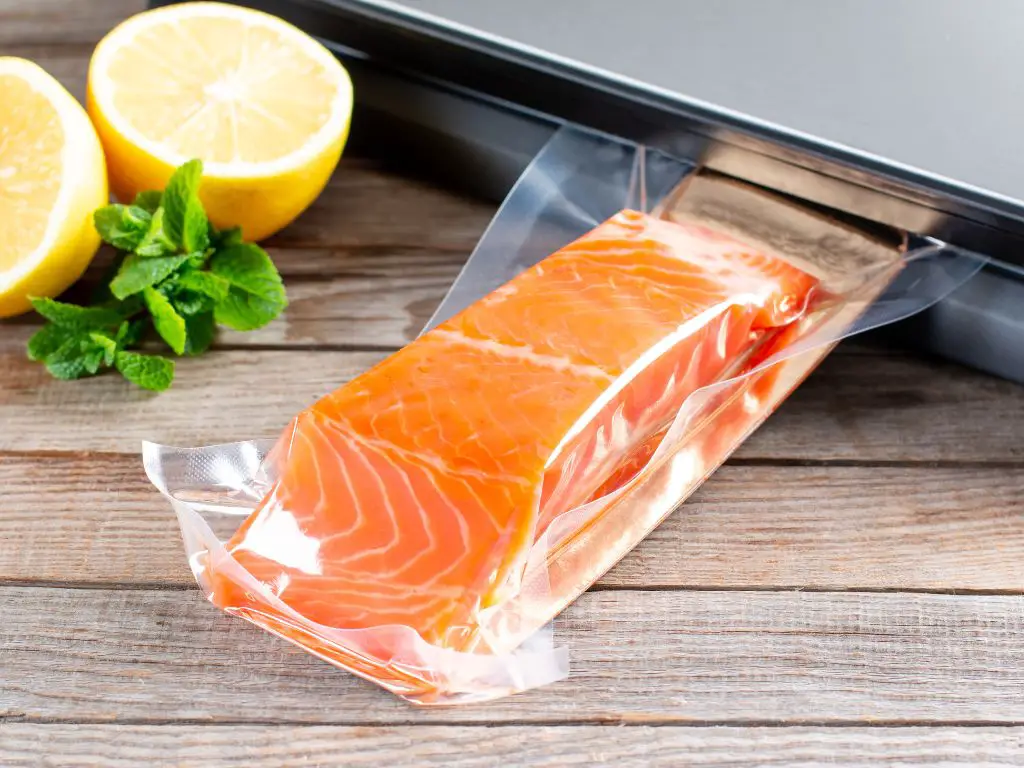Vacuum packaging is a popular method for preserving foods and reducing food waste. However, there are some downsides to be aware of when vacuum sealing foods.

Sous Vide Products I Use Every Day
As an Amazon affiliate, I earn from qualifying purchases.
Last update on 2024-07-26 / Affiliate links / Images from Amazon Product Advertising API
Potential for Bacterial Growth
While vacuum packaging creates an anaerobic environment that limits aerobic bacterial growth, some dangerous bacteria like Clostridium botulinum thrive in oxygen-free environments. This bacteria can produce toxins that cause botulism, a life-threatening illness. Proper refrigeration and freezing is essential to prevent C. botulinum and other anaerobic bacteria from growing.
Loss of Food Quality
Vacuum packaging can accelerate deterioration of certain foods over time compared to proper freezer storage. The lack of oxygen can cause faster breakdown of vitamins, fats, and other nutrients. Vacuum sealing can also lead to freezer burn on meats, discoloration of vegetables, and drying out of foods. Proper freezing techniques and not over-freezing foods can help maintain quality.
Limited Shelf Life
Vacuum sealed foods have a longer but still limited shelf life compared to properly frozen foods. Most vacuum sealed foods last around 2-3 years frozen. High fat foods like cheese may only last a few months. For maximum shelf life, store vacuum sealed foods below 0°F.
High Initial Costs
Vacuum sealing requires special equipment like a vacuum sealer and bags or jars, which can be an expensive initial investment. Machines range from $50-$500 and bags/containers are an ongoing cost. For infrequent use, the costs may not justify the small benefits over freezer bags.
Difficulty Packaging Some Foods
Vacuum packaging works best for solid, dry foods. Foods with a lot of liquid can be challenging to vacuum seal properly. Liquids may get sucked out or can damage the seal. Soft foods and produce like berries are also difficult to vacuum seal optimally.
Environmental Concerns
Most vacuum bags are not reusable and are made of plastic, creating more single-use plastic waste. However, reusable bags and glass jar systems are available for more eco-friendly vacuum sealing. Properly disposing of used bags is important to minimize environmental impact.
Health Risks of Plastics
Some concerns have been raised about the safety of plastic vacuum bags and containers that directly contact food. Chemicals may leach into foods, especially fatty foods, and some plastics contain bisphenol-A (BPA) or phthalates that can act as endocrine disruptors if consumed. Using BPA/phthalate-free bags can help minimize risks.
Not Suitable for All Foods
Vacuum sealing is only suitable for shelf-stable foods and cannot be used to seal perishable foods for room temperature storage. It also cannot enable refrigeration-only foods like fresh meats to be stored at room temperature safely. Proper refrigeration or freezing is still needed for most vacuum sealed foods.
Careful Handling Required
Sharp foods can puncture vacuum bags, compromising the seal. Proper sealing technique and avoiding overfilling bags reduces this risk. Vacuum sealed items must also be thawed carefully to avoid rupturing the bag. Microwaving vacuum sealed foods can be dangerous due to steam buildup inside the bag.
Can Alter Taste and Texture
Vacuum packaging alters the oxygen exposure that can impact flavor profiles and food textures, especially over longer storage times. So vacuum sealed foods like vegetables and fish may taste different than if freshly prepared.
Minimizing the Disadvantages
Proper food selection, packaging, labeling, freezing technique, and storage can help maximize food quality and safety when vacuum sealing. Reusable and BPA/phthalate-free bags also help reduce environmental and health impacts. For foods that do not vacuum seal well, freezer bags can be a better choice. Overall, vacuum sealing has some downsides to consider, but can extend shelf life if done carefully.
Alternatives to Vacuum Packaging
While vacuum sealing has some advantages, there are other food preservation methods that may be better options in certain situations:
- Freezer bags – Regular freezer bags filled with air can achieve adequate freezer storage for many foods when used properly. They avoid some downsides of vacuum sealing.
- Food dehydrating – Removing moisture preserves many fruits, vegetables, and meats at room temperature without chemicals or plastic.
- Canning – Heat processing in mason jars enables shelf-stable storage of fruits, vegetables, meats, and more with minimal plastic waste.
- Curing and smoking – Ancient preservation techniques like curing, smoking, and salting prolong shelf life of meats and fish without modern packaging.
- Cold storage – Storing produce and other perishables in cold cellars, caves, or natural refrigerators preserves them for months with no plastic waste.
- Freeze drying – Removes moisture like dehydrating but maintains more nutrition and original texture. Requires special equipment.
- Lactic acid fermentation – Fermenting foods like kimchi, pickles, and sauerkraut preserves them using natural bacteria and enzymes present.
- Sugar preservation – Jams, fruit preserves, and crystallized fruit last for long periods preserved in sugar concentrations.
- Salting – Heavily salting fish, meat, dairy, and vegetables significantly extends storage life and food safety.
Many traditional and modern techniques can achieve long shelf life with less reliance on plastics than vacuum sealing. Proper cold storage is also key for short-term storage of fresh perishables. Considering all preservation options allows selection of the optimal technique for each food type and use case.


![IMPRESA [10 pack] Sous Vide Magnets to Keep Bags Submerged & In Place - Sous Vide Accessories to Stop Floating Bags & Undercooking - Great Alternative to Sous Vide Weights, Balls, Clips, & Racks](https://m.media-amazon.com/images/I/41zHpl8G2lL._SL160_.jpg)


